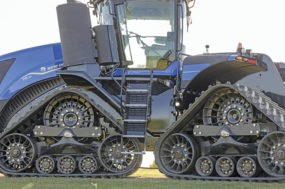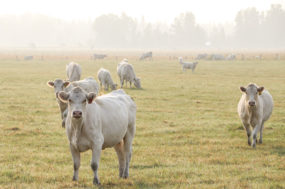Let’s talk about water – irrigation water – specifically, the things affected by irrigation water: summer forage, business risks and the possibilities for change.
Every summer, livestock producers across the Midwest and East watch the sky and hope for rain. Pastures and hay fields need water, of course – and across a broad swath of central and eastern North America, the only source is the sky. Thunderstorms are usually welcome unless they wash away the barn, and so are the occasional weather fronts that can bring a steady two-day rain. But if three or four weeks pass without rain, the ground becomes mighty dry. In addition, many cool-season forages regularly go into a midsummer slump, when their yields drop precipitously for two months.
You might ask: Why don’t we irrigate? Well, how much of a gambler are you? Supplementary irrigation comes with a heavy load of costs and risks: the cost of irrigation equipment, the cost of running the pumps, the labor to move pipes all summer, the potential high price of fertilizer¸ the chances of a bad market year – these are all real factors. In the past, most university budgets have shown that supplementary irrigation in these areas is a very iffy proposition at best, that for Eastern and Midwestern pastures it usually doesn’t pay. So, year after year, summer after summer, we watch the sky and hope for rain.
In the West, irrigation is a fact of life. Water is limited, and entire agricultural communities are built around strict water laws – who can use it, how much and when. Even in rainy western Oregon, the summers are actually bone dry, and nothing grows during the summer without irrigation. Farmers and ranchers here are very familiar with irrigation costs and equipment. During the past 15 years, however, the world of irrigation has experienced a revolution in supplying water to pastures.
We’ve seen the development of pod-line irrigation systems. (The most well-known is the “K-Line system,” but there are other brands on the market. In this article, I’ll call them pod-line systems to avoid favoritism.) This equipment is specifically designed for pastures, even for irregularly shaped fields. These systems use less water than most traditional irrigation equipment, and they use that water more efficiently.
Once or twice a day, one person on a four-wheeler moves the pods and hoses across the field, usually in less than 30 minutes, without even turning off the water. Although a pod-line system is not cheap – the steady flow of low-pressure water, like a gentle rain; the ease of movement; the labor efficiency; the labor savings over time – a pod-line system is a horse of a very different color than traditional irrigation equipment.
Let’s outline the situation for graziers east of the Mississippi River. Most Eastern pastures contain a combination of legumes and cool-season grasses, with warm-season grasses becoming dominant during the summer months in the South. Every forage textbook depicts the forage production year as a two-humped curve: the high hump of spring growth, then a deep trough known as the summer slump, then a second smaller hump in the fall, and finally the curve drops to zero after the killing frost.
Every year, graziers face the issues of excess spring growth, insufficient summer feed and the challenge of saving something in their fields for winter. But the good news is: most Eastern and Midwestern farmers may also have relatively easy access to streams or groundwater.
So let’s take a fresh look at the potential for irrigating these summer pastures. Farm economists scrupulously develop spreadsheets that compare forage yields with and without irrigation, taking into account the investment and operational costs of irrigation, the market value and nutritional quality of the extra forage yield and some current prices. Spreadsheets are wonderful inventions – they rank right up there with hot showers and bowling – but their calculations tend to be one-dimensional.
Grass-based livestock operations, however, are not one-dimensional; decisions in any one part of the operation affect the whole operation. If we install a pod-line irrigation system into a grass-based grazing operation, opportunities and possibilities can open up that might not appear in a spreadsheet. These may be possibilities worth considering. Let’s go there.
If we apply water to summer pastures, the first and most obvious result is greater yield, which translates to more grazing days (which equals more livestock on the pasture for the same number of summer days) or more hay. This yield response is typically the main focus of a spreadsheet budget.
But increased yields also imply an important proviso: The forage species in the pasture must be capable of producing increased yields during the hot summer weather. Overgrazed and poorly managed fields may no longer contain high-producing forages. Also, some species like Kentucky bluegrass and perennial ryegrass tend to go dormant in the midsummer heat, so their fertilizer response, even with extra water, may be disappointing.
But here’s where we take leave from most of the spreadsheet analyses. If you were certain your fields would have water 100% of the time throughout the summer, you could really change some things. The risk of a water shortage disappears, and you can choose to do things on your farm that would otherwise seem much too risky. For example, you could purchase lots of fertilizer for those fields because you are confident it would not be wasted.
Speaking of summer yields, you could consider making changes in the mix of forages in those fields. Instead of relying on the old standbys of bluegrass and white clover, maybe you could afford to renovate – possibly introducing new, highly productive varieties of orchardgrass, Matua prairie grass, festulolium, red clover, chicory, meadow brome, alternative legumes and endophyte-free or novel endophyte tall fescues. Lots of choices.
Or instead of relying on permanent pastures, you might consider making a major change by planting one or two fields to high-production annuals, especially if you are confident about spending money for fertilizer to support their explosive yields. Forages such as Italian ryegrass or the new hybrid forage brassicas, etc., or forages that really specialize in summer growth: the warm-season grasses like sorghum-sudangrass, grazing corn, teff or millet, along with any of an intriguing array of legumes. Again, more choices.
Having lots of forage during the summer opens up some additional possibilities. You could graze more animals on that acreage, and that translates into carrying more breeding stock or retaining weaned calves or lambs on annual pastures. If you’ve been feeding hay during the summer, that hay could be postponed for use during the winter, or maybe you wouldn’t even need so much hay.
Here’s another thought: If you had extra forage during the summer, perhaps you could sell it through someone else’s animals – like making arrangements for contract grazing, especially using a different livestock species to reduce the parasite load or multi-species grazing by contract. People could pay you to rent the acreage, or they could pay you on the gain. Your risk of ownership becomes zero. Alternatively, of course, you could buy additional livestock for grazing, but then you assume the risk of owning them.
Another possibility: If you are confident about growing lots of additional forage on irrigated fields, you might also save on winter feed by winter stockpiling. Even with partial irrigation, a good stand of tall fescue, managed and fertilized properly, could be saved back as standing feed for the winter. This is a well-known technique in many areas of the country – and on your place, irrigation might make it possible. Or if you plant one of the new hybrid forage brassicas or kale or even leafy turnips, you’ll find these plants can easily stand into the winter, again reducing the need for winter hay.
Let’s think even bigger. Let’s think about the entire production year. If you’ve always lambed during the winter but now are guaranteed high-quality forage throughout the summer, why lamb in the winter? If lambing occurred during midspring or later, you could get through the winter without having to worry about making and storing high-quality feed, and you could also carry more ewes in better condition during the summer. If you weaned the lambs relatively early, they could be grazed on other fields or be fed separately near the barn, and you’d have lots of good-quality feed for the ewes all summer. So you could run more ewes. Or run fewer ewes and take a vacation.
Or ... well, you get the drift. Adding water to summer pastures can profoundly impact the operation. It changes the risks of making changes and opens a world of possibilities. Pod-line systems do more than bring water to pastures; they open doors. So when you look at a budget for supplementary irrigation, look beyond the numbers in those spreadsheets. The old Beach Boys song “Wouldn’t It Be Nice” was really about irrigating our pastures.










